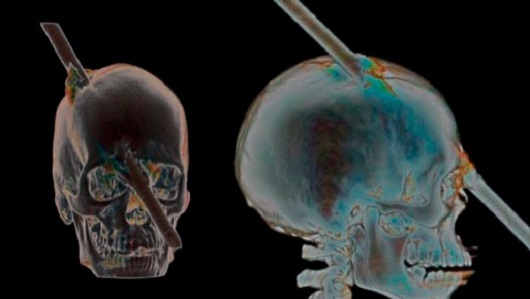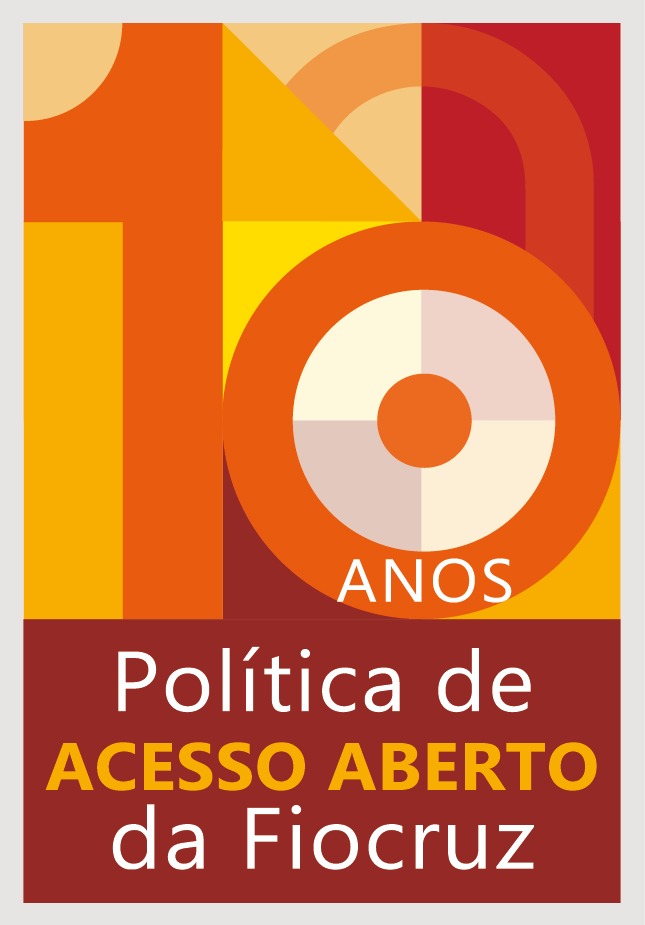Head trauma reveals brain compensation mechanism
31/08/2022
Fiocruz News Agency (AFN)
In 1848, Phineas Gage, a 25-year-old American railroad worker had his skull pierced by an iron bar, which caused damage to his frontal lobe. After that, Gage showed changes in his personality, attributed at the time to possible injuries to his left frontal region. On August 15, 2012, 24-year-old Brazilian E.L. suffered a similar accident at a construction site: a rebar fell from the 5th floor piercing the right side of his skull and his frontal lobe. With a separation of 164 years, the study of E.L.'s injuries – involving researchers from Fiocruz, the Federal University of Rio de Janeiro (UFRJ), the Albert Einstein College of Medicine (USA) and New York University (USA), among others – helps to discover the process of brain compensation after frontal lobe trauma, sheds light on Gage's case and paves the way for medical treatment.
The E.L.'s x-ray: the research helps to discover the process of brain compensation after frontal lobe trauma and paves the way for medical treatment (image: Fiocruz)
E.L., a modern-day Phineas Gage: Revisiting frontal lobe injury, published in the scientific journal The Lancet Regional Health - Americas, is the doctoral thesis of Pedro de Freitas, supervised by neurophysiologist Renato Rozental, professor in the Postgraduate Course of Pathological Anatomy at the Faculty of Medicine, Federal University of Rio de Janeiro (UFRJ), and researcher at the Center for Technological Development in Health (CDTS/Fiocruz). The article is the result of nine years of painstaking multidisciplinary work on functional changes in the prefrontal cortex, and brought together renowned national and foreign experts.
The Prefrontal area of the cortex corresponds to the anterior, non-motor part of the frontal lobe and constitutes the most sophisticated reflection of human evolution. Evolutionarily speaking, it was the last cortical region to develop. It is in this area that the most complex mental, behavioral and cognitive processes occur. It is, for example, responsible for choosing behavioral options and strategies, maintaining attention, planning, and controlling emotional behavior.
Similarities separated by two centuries
The coincidences are many. Besides the similarities in accidents, ages and education levels, both lost about 15% of brain mass: in E.L.'s case the lesion was in the right frontal lobe, and in Gage's case, in the left one. However, the research with the Brazilian patient was able to count on a series of resources not available at the time of the American, such as tomography, electroencephalogram, magnetic resonance imaging, modulation of the brain electrical activity and neuropsychological exams structured to evaluate frontal lobe dysfunctions, which helped to estimate the lesions and their consequences.
From then on the records differ. Reports indicate that Gage, after the accident, became irritable, rude, and undisciplined. It is common to see descriptions that he “was no longer the same man.” E.L., however, showed no changes in behavior, but did exhibit other symptoms, such as post-traumatic epilepsy, controlled with medication.
"Initially, Gage had no change in behavior. But he did have a perilous inflammatory process and a major infection - antibiotics were not available at the time - which may have contributed to the manifestations of these changes. But that doesn't mean that they were permanent. There were not the medical and technological resources of today, and between the first and the second documentation 15, 20 years had passed", observed Renato Rozental, reminding that inflammation and infection can lead to alterations in the pattern of brain electrical activity. "He traveled to other countries performing. And the accounts of when he lived in Chile do not describe a rude man. There, he worked as a coachman. He dealt with horses, which are sensitive animals, and transported passengers in carriages. He was considered a polite, sensitive and responsible person. I believe in the authenticity of the reports of the doctor who examined him in Chile because our results show that [brain] compensation in patients with unilateral frontal lesions is possible if there is no demand to perform several tasks at the same time, a process known as 'multitasking'", added the CDTS/Fiocruz researcher. "Our study contributes to the understanding of the Phineas Gage case, considered one of the great mysteries of neuroscience.”
Starting from scratch
There was no autopsy, and what remains of Gage today is the perforated skull and the iron bar. The frontal lobe is important for decision making, planning, short-term memory, family and social interaction - hence they thought that the injuries were responsible for the change in behavior. In E.L.'s case, the idea was to start from scratch, without being influenced by past conclusions. From the very beginning, the Brazilian's left frontal lobe began to compensate for the right. Rozental explained that if the healthy hemisphere “is not actively recruited” to another activity, it can compensate for the injured one. In a simple test done with E.L., for example, he needed to quickly touch each finger of the same hand with his thumb, which he did without problems. The same with the other hand. But when he needed to do both at the same time (multitasking), the healthy hemisphere could not compensate for the right one.
“The study helps to understand the abnormal electrical activity that arises in the perilymph area,” Rozental noted. The study also paves the way for treatments in case the brain does not make up for this. By means of drugs and even brainwave stimulation, it is possible to get one hemisphere to compensate for the lesioned areas in the other, as long as the lesions are not bilateral. In the area with lesions, slow electrical waves of high amplitude arise. “If we modulate this abnormal electrical activity that arises in the injured hemisphere, these slow waves, we can reduce their frequency and the person can have their executive function normalized,” explained the Fiocruz researcher.
But it was necessary to be sure about this “mirroring”. The proof of concept was made through the Transcranial Magnetic Stimulation (TMS) technique: it temporarily “turns off” an area by stimulating the cerebral cortex. If this area was controlling the activity in the other hemisphere and is switched off, electrographic differences appear in recordings, and the patient's functional ability is markedly altered and scaled. This reinforces the concept that the healthy area was modulating the injured one.
"Identifying compensatory responses associated with LFO [low-frequency oscillatory activity] over the injured hemisphere may facilitate determination of the extent to which neural recruitment in injury represents reorganization or functional engagement of existing latent networks," says the paper published in the Lancet.
Normal Life
To analyze the functional modifications of the prefrontal cortex, unique in humans, a team was assembled that, in addition to Brazilians, included the collaboration of international researchers in the fields of neuroscience, neurology, internal medicine, and neuropsychology, such as Rodolfo Llinas (NYU), Michael Bennett (Albert Einstein College of Medicine, NYU), Elkhonon Goldberg (NYU and current Director of the Luria Institute, NY), and Oliver Sacks until August 2015, when he passed away. At UFRJ, there was the support of Prof. Mario Fiorani and physician Marcos Martins, specialists stationed at IBCCF and HUCFF.
“These findings mean that a focus on recruiting the intact hemisphere to aid recovery may be a valuable direction for effective clinical treatments that will allow recovery of compromised function and achieve a better quality of life for patients,” Rozental noted. “While there is no doubt that following the brain infection there were changes in Gage's personality, our study substantiates reports of his recovery and resumption of something resembling a ‘normal life,’ significantly impacting our understanding of brain plasticity and assisting physicians with structuring a treatment strategy.”
E.L., in turn, despite having lost 11.2% of his total brain mass, leads a basically normal life. Due to post-traumatic epilepsy, he can no longer work in construction, but he has controlled the episodes with anticonvulsant medication and performs other tasks. His family and social interactions also remain the same. He still has some mild symptoms, such as a subtle asymmetry of reflexes between his left and right arms. "There were no noticeable declines in his mental processing, moral reasoning, social behavior, ability to solve daily problems, ability to interact with his co-workers or family members, or ability to act efficiently," the article says.
"In summary, our study suggests that modulation of low-frequency wave dynamics is an important mechanism by which the prefrontal cortex accommodates neurological injury, supporting reports of Gage's recovery and representing an attractive new target for therapeutic interventions," Rozental noted.
Research
Other participants in the study included Raphael M. Bertani, Caio M. Perret, Pedro C. Rodrigues, Joana Vicentini, Tagore M. Gonzalez de Morais, Gustavo F. Galvão, Fabricio de Mattos, Guilherme L. Werneck (UFRJ), Ruy C. Monteiro and Ivan S. Dorio (Miguel Couto Hospital, RJ), Stefano F.A. Rozental (Vassar College, Poughkeepsie, NY), Fernando A. Vasconcelos (Hospital Miguel Couto, Unirio), Cintya Y. Hayashi and Wellingson S. Paiva (Unesp), Jorge R.L. dos Santos (PUC, RJ), Carla T. Ferreira Tocquer (Centro de Neurologia da Cognição e do Comportamento), Claudia Capitão (Centro Universitário, IBMR), Luiz C. Hygino da Cruz Jr (MRI Clinica de Diagnóstico por Imagem CDPI/DASA), Jaan Tulviste (University of Tartu, Estonia), Kenneth Podell (Neurological Institute, Houston Methodist), Howard J. Federoff (Georgetown University), Divyen H. Patel (Genome Explorations, Memphis, TN), and Fred Lado (Northwell Health, Manhasset, NY).
The research was funded by the Rio de Janeiro Research Foundation (FAPERJ), the Federal University of Rio de Janeiro, and Fiocruz/Ministry of Health (INOVA Fiocruz).




